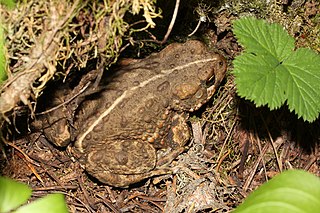
The western toad is a large toad species, between 5.6 and 13 cm long, native to western North America. A. boreas is frequently encountered during the wet season on roads, or near water at other times. It can jump a considerable distance for a toad. Breeding occurs between March and July in mountainous areas, and as early as January in lower-elevation regions. The female lays up to 17,000 eggs stuck together in strings that adhere to vegetation and other objects along water edges.

The southern toad is a true toad native to the southeastern United States, from eastern Louisiana and southeastern Virginia south to Florida. It often lives in areas with sandy soils. It is nocturnal and spends the day in a burrow. Its coloring is usually brown but can be red, gray, or black. It is approximately 8 cm (3 inches) long.
The Almirante Trail toad is a species of toad endemic to Panama. It is only known from its type locality near Boquete, Chiriquí, in western Panama. Another population from Cerro Bollo that has been referred to this species was described in 2013 as a separate species, Incilius majordomus.
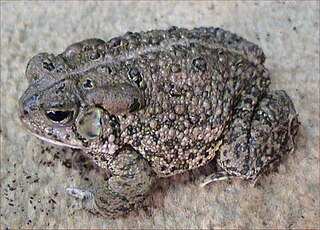
Woodhouse's toad is a medium-sized true toad native to the United States and Mexico. There are three recognized subspecies. A. woodhousii tends to hybridize with Anaxyrus americanus where their ranges overlap.

The Mongolian toad, also known commonly as the piebald toad or the Siberian sand toad, is a species of toad in the family Bufonidae. The species is endemic to northeastern Asia. It was formerly placed in the genus Bufo, then for a few years in Pseudepidalea until finally moved to its own genus Strauchbufo.
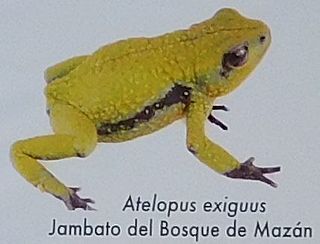
Atelopus exiguus is a species of toad in the family Bufonidae. It is endemic to Ecuador and only known from the area of its type locality in the Azuay Province of southern Ecuador, in the sub-páramo and páramo of Cordillera Occidental. Common name Mazán jambato frog has been proposed for it.
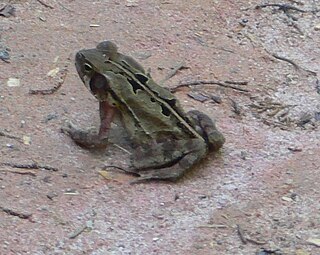
Rhinella crucifer is a species of toad in the family Bufonidae. It endemic to Brazil and known from the Atlantic Forest of eastern Brazil between the states of Ceará in the north and Rio de Janeiro in the south. Common name striped toad has been coined for it. "Rhinella pombali" is a hybrid between Rhinella ornata and this species.

Incilius ibarrai is a species of toad in the family Bufonidae. It is found in the central and southern highlands of Guatemala and adjacent Honduras. The specific name ibarrai honors Jorge Alfonso Ibarra (1921–2000), then-director of the Guatemalan National Natural History Museum.

The Japanese common toad, Japanese warty toad or Japanese toad is a species of toad in the family Bufonidae. It is endemic to Japan. Its natural habitats are subarctic forests, temperate forests, temperate shrubland, swamps, freshwater marshes, intermittent freshwater marshes, freshwater springs, arable land, rural gardens, urban areas, ponds, and irrigated land. Amplexus is the mating behaviour involved in the Japanese common toad during the breeding season.
The little Mexican toad, formerly Bufo kelloggi, is a species of toad in the family Bufonidae. It is endemic to Mexico and found in the Pacific coastal plains between central Sonora and Nayarit. The specific name honors Remington Kellogg, who was an American zoologist and a director of the United States National Museum.

Sclerophrys kerinyagae is a species of toad in the family Bufonidae. It is found in central Ethiopia, Kenya, northern Tanzania, and eastern Uganda. Common names Keith's toad and Kerinyaga toad have been coined for it.
Sclerophrys kisoloensis is a species of toad in the family Bufonidae. It is found in southwestern Kenya, Uganda, Rwanda, eastern Democratic Republic of the Congo, northeastern Zambia, western Tanzania, and northern Malawi. It probably also occurs in Burundi. Common names Kisolo toad and montane golden toad have been coined for it.

Incilius melanochlorus, formerly Bufo melanochlorus, is a mid-sized species of toad with a crested head in the family Bufonidae. It is primarily distinguished by its very long first finger with respect to the other fingers. It is found in southern Nicaragua, in the northern Cordillera Central and on the Atlantic slopes of eastern Costa Rica, and in western Panama.
Werner's toad is a species of toad in the family Bufonidae. It is found in northwestern Guyana and eastern Venezuela at elevations of 500–1,350 m (1,640–4,430 ft) asl.
Bufo pageoti, also known as Tonkin toad or Burma(n) toad is a species of toad in the family Bufonidae. It is found in southern China (Yunnan), north-east and western Myanmar, and northern Vietnam. It is a medium-sized toad, with males measuring about 64 mm (2.5 in) and females about 67 mm (2.6 in) in length.

Phrynobatrachus bequaerti is a species of frog in the family Phrynobatrachidae. It is found in the mountains of north-western Burundi, eastern Democratic Republic of the Congo, and western Rwanda. The specific name bequaerti honours Joseph Charles Bequaert, a Belgian botanist, entomologist, and malacologist and who collected the holotype from Mount Vissoke. Common name Vissoke river frog has been coined for this species.
Phrynobatrachus keniensis is a species of frog in the family Phrynobatrachidae. It is found widely in the highlands of Kenya. It is also recorded from Mount Meru in northern Tanzania, but this might represent a different species. Common names Kenya River frog and upland puddle frog have been coined for it.
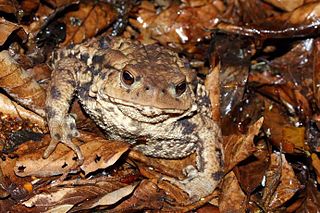
Bufo eichwaldi, commonly known as Eichwald's toad or the Talysh toad, is a species of true toads in the family Bufonidae. It was first described by Litvinchuk, Borkin, Skorinov and Rosanov in 2008 and is found in the Talysh and Elburz Mountains in Azerbaijan and parts of northern Iran. It was previously considered to be a subspecies of the Caucasian toad.
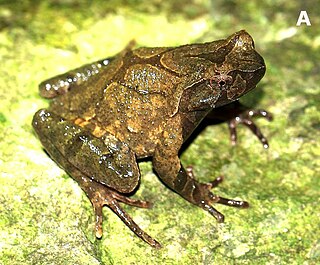
Boulenophrys lini is a species of frogs in the family Megophryidae. It is endemic to Luoxiao Mountains at the border of the Jiangxi and Hunan provinces in southeastern China. Its specific name honours professor Ying Lin (1914–2003), botanist and vice chancellor of Nanchang University who conducted biodiversity surveys and research in the Jinggang Mountains.















